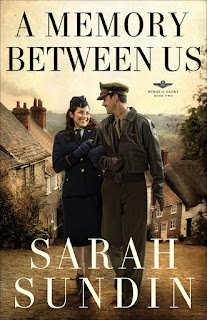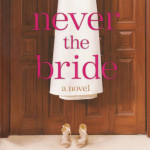Sarah Sundin’s A Memory Between Us was my book club’s March selection and we had the pleasure of a lengthy Q&A with Sarah via email. Sarah was very generous answering each of our questions about her book, writing, research and faith.
 Our discussion about the book was interesting as we chatted about the time period, the characters, prejudices and how we would cope living in wartime conditions.
Our discussion about the book was interesting as we chatted about the time period, the characters, prejudices and how we would cope living in wartime conditions.
 Both Sarah and I hope you enjoy Part 1 of our interview 🙂
Both Sarah and I hope you enjoy Part 1 of our interview 🙂
RBC:~ I noticed  on your bio that you teach lessons from the 40’s woman and your novel reflects a passion for this era. How does this influence your life, faith and relationships around you?
on your bio that you teach lessons from the 40’s woman and your novel reflects a passion for this era. How does this influence your life, faith and relationships around you?
SARAH:~ The more I study this era and what the men and women faced, the more impressed I am with them. They were dedicated to home, family, and community. They worked hard and were people of integrity. They persevered through difficult times. Their example makes me evaluate my own life and see where I fall short.
I did enjoy your novel and the challenges facing each of the characters. I had a soft spot for May who epitomises perseverance and hope despite hardship and wondered how you developed her character?
When I was young, I think I read too many books about poor little orphan girls. May arose from the simple story need for a friend for Ruth, someone for Ruth to interact with and to help Ruth grow. Both women faced great hardship, but Ruth chose to pull away from people while May chose to reach out. Ruth lost her faith, but May kept hers. But the fact that May was orphaned, hurt, and rejected gave her clout with Ruth. What surprised me while writing the story was how their friendship became balanced, and how Ruth was able to help May also.
There is a lot of detail in this story – can you talk about how you approach your research?
Historical inaccuracies in fiction annoy me, so I tried to make my stories as accurate as possible. I have to confess, I have over two hundred books and websites in my bibliography. Yes, that’s sick. I started with basic texts on World War II, then got more detailed. Bibliographies are a great resource—when a book is mentioned in multiple bibliographies, it warrants attention. My local library has found some obscure books for me.
How long have you been interested in that period of history / the military / did anything in particular start your interest?
I’ve always had a moderate interest in World War II. When I had the idea for A Distant Melody, the first book in the series, I knew it had to happen during World War II. Then my husband and I watched a documentary on the US Eighth Air Force, and I was hooked. Since my great-uncle was a B-17 pilot with the Eighth, I had access to his stories and letters. I started my basic research and became enthralled with the era.
How long was this story plotting away in your head before you decided to get serious a nd write a novel about it?
nd write a novel about it?
I had the basic idea for this story in 2002, while I was writing A Distant Melody. This story grabbed me, and I took a few months to dash off about a hundred pages and do some preliminary research. Then I set it aside, finished and polished A Distant Melody, completed the research, then sat down to write the rough draft in 2004.
What was your process for writing this novel?
Since I didn’t have a publishing contract at the time, I had the luxury of time. I spent a full year doing research and my “pre-writing”—outlining, character analyses, etc. Then I wrote the rough draft, then edited it thoroughly. It took quite a while to sell the series, so it went through many edits. I’ve lost count.
Your descriptions of the planes are impressively detailed. Could you tell us about the research you did for this story?
There are a lot of excellent books and websites about the Eighth Air Force,  including wonderful oral histories. Since I’ve never flown a plane, I first read a “How to Fly a Plane” book to get the basics. I also used a copy of the actual B-17 pilot’s manual and the Army Air Force training film, and ran the flying scenes past a pilot friend. Two organizations tour the United States with beautifully restored B-17s, and you can walk through them for a nominal fee. Wow! When you crawl through the narrow passageways, duck through the doorways, and poke your head into the top turret—and then imagine doing it as a full-grown man with heavy high-altitude flying gear in subzero temperatures under fighter attack—it gives you a new level of appreciation for what the airmen went through.
including wonderful oral histories. Since I’ve never flown a plane, I first read a “How to Fly a Plane” book to get the basics. I also used a copy of the actual B-17 pilot’s manual and the Army Air Force training film, and ran the flying scenes past a pilot friend. Two organizations tour the United States with beautifully restored B-17s, and you can walk through them for a nominal fee. Wow! When you crawl through the narrow passageways, duck through the doorways, and poke your head into the top turret—and then imagine doing it as a full-grown man with heavy high-altitude flying gear in subzero temperatures under fighter attack—it gives you a new level of appreciation for what the airmen went through.
What advice would you give someone who wants to get into writing?
Be teachable and soak up all the good instruction you can. Read books on writing craft, and then read your favorite authors and analyze how they did it.
Join a local writers’ group or an on-line critique group.
Don’t submit to agents and editors until you’re ready. That means a complete manuscript, positive feedback from experienced writers, and enough knowledge of the publishing industry to know how to submit properly. You want your first impression to be stellar.
Lastly, when you’re ready, submit and keep submitting. Keep polishing your craft, and keep praying for the Lord’s guidance.
What made you  want to get into writing?
want to get into writing?
I didn’t. Although I always read voraciously, I never considered a writing career. Instead I chose a practical career in pharmacy which allowed me to work on-call and stay home with our three children. Then in 2000, I had a dream with such intriguing characters that I felt compelled to write their story. That first novel will never be published, nor should it, but it got me started.
What was your favourite scene(s) to write?
I have so many in this book. Any time I put Jack and Ruth in the same room, the banter flew. I just transcribed their dialogue. I think one of my favorite scenes is when Jack & Ruth visit the ruined abbey in Bury St. Edmund. In that scene I got to  write fun banter, a sweet tender part, a deeply romantic part, a painful flashback, and a hysterical rant! That was a good writing day.
write fun banter, a sweet tender part, a deeply romantic part, a painful flashback, and a hysterical rant! That was a good writing day.
Which character did you connect with most as you wrote the story?
It has to be Ruth. She fascinated me. On the surface she is so strong she doesn’t need another human being—and she has a great sense of humor. But underneath she has deep hurts and shame. It was fun for me to tease out what made her the way she is and to watch her change and grow.
Ruth is a complex character. What or who was your inspiration as you told her story?
Just my own strange imagination, I’m afraid. She’s not based on any real person or incident. However, as a little girl, I was fascinated by stories of orphans in peril, so maybe that’s where it started. Ruth came from an idea about a poor girl who makes a shameful decision to feed her family. I wondered what kind of girl would make such a decision, what consequences she would face, and what she’d be like when she grew up. And there was Ruth—strong, confident, clever, independent, prickly—but vulnerable inside.
How have your great-uncle’s wartime experiences impacted on you personally, and your extended family?
I grew up listening to my grandfather relating his brother’s wartime stories as well as his own (he was a medic in the US Navy). We all took pride in his background. The more I’ve researched, the more I admire what he went through.
What does a typical writing day look like for you?
typical writing day look like for you?
My children are 12, 15, and 18, with the oldest one away at college, so I do most of my writing during the school day. First I run through e-mails and social media sites for about an hour, and then I settle down to write until the kids come home from school. I do more on-line work while they’re doing homework. Thanks to the laptop, I do a lot of work on the go. Also I do things like this interview on the laptop in front of the TV while my family watches their shows.
Do you plan out the entire story before you start writing?
I do. I’m definitely an outline-oriented writer. I fill out lots of character and plot charts, and have each chapter loosely outlined before I start the rough draft. However, often the story will still surprise me, especially the characters. Then I modify my outline if necessary.
If A Memory Between Us was made into a movie which actors would you like to see in the various roles?
I’d cast Maureen O’Hara as Ruth, and a young Clark Gable as Jack—more from It Happened One Night than Gone With the Wind, but without Gable’s dimples and ears.
What do you find the enjoyable aspect to writing and the most challenging?
I love so many aspects of writing—research, planning, writing the rough draft, even editing. I ’m not as fond of publicity, but it’s a necessary evil.
’m not as fond of publicity, but it’s a necessary evil.
Are you working on a project at the moment?
Several. I’m still doing publicity for A Distant Melody and A Memory Between Us. I’m working on my publisher’s final edits for the third book in the series, Blue Skies Tomorrow, I’m about halfway through the rough draft of the first book in my next series, plus I’m planning out the next two books in that series. The author’s life is a juggling act.
I hope you have enjoyed this interview with Sarah ~ look for Part Two later this week!
Relz Reviewz Extras
Review of A Distant Melody
Character spotlight on Allie & Walt











April 24, 2011 at 5:37 pm
Thanks, Rel! And the pictures are fabulous! That's a great picture of the ruins at Bury St. Edmunds, and that's the cover of the B-17 manual I own 🙂
April 24, 2011 at 9:01 pm
Great interview ladies!
I am a huge fan of Maureen O'Hara and Clark Gable. I'll have to read this and imagine them in the leads.
Happy Easter Rel!